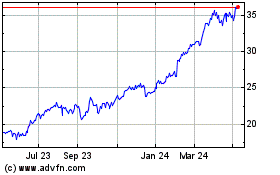By Max Colchester and Jenny Strasburg in London and Deborah Ball in Milan
European regulators gave most banks a clean bill of health in
"stress tests" despite the Continent's sluggish growth and low
interest rates, saying only a clutch of lenders would struggle to
ride out a hypothetical severe economic downturn.
The European Banking Authority released results Friday of its
latest stress test showing how much capital, or cushion against
losses, banks would have left on their balance sheets in an adverse
economic scenario. The tests come after European banks climbed out
of the 2010 eurozone crisis but have continued to grapple with low
profits, bad loans and, sometimes, management problems and
turnover, all of which have translated into struggling stock
prices.
Struggling Italian lender Banca Monte dei Paschi di Siena SpA
was at the bottom of the pack of 51 banks assessed, underscoring
investor sentiment that the bank is a worrisome vulnerability in
the country's system and needs to raise substantial funds.
Other major banks that suffered sizable hits to their capital
buffers included UniCredit SpA, Barclays PLC and Deutsche Bank
AG.
Hours before the results were made public, the board of Monte
dei Paschi unveiled a plan to unload nonperforming loans and raise
up to EUR5 billion ($5.54 billion) in capital. Because the
Siena-based bank was expected to be the worst performer in the
test, its management was eager to come up with a plan to head off a
crisis of confidence following release of the results.
The bank said the tests didn't take into consideration its new
plan to raise capital and unload sour loans.
The European Central Bank said the exam used a less severe
scenario than the toughest one used in stress tests for U.S. banks
in June, in which 31 out of 33 U.S. lenders, including big firms
such as Bank of America Corp. and Citigroup Inc., passed. In
addition, the European Union tests didn't include struggling Greek
and Portuguese banks this year, which could help account for the
relatively rosy results despite Europe's woes. Such lenders are
being privately tested by regulators, and the results won't be made
public.
In addition, the banking authority's toughest economic scenario
didn't factor in negative interest rates or the effects of a U.K.
pullout from the EU. Regulators said the scenarios tested were
gloomier than most of the predicted impact from the Brexit
vote.
Unlike in previous European stress tests, regulators didn't
include a pass or fail result for each bank related to a specific
capital amount. Instead, the EBA has left it up to investors and
regulators to interpret the results.
Broadly, investors were looking for banks to maintain at least a
5.5% ratio of top-quality capital in the test scenario, analysts
said.
Of the "systemically important" European banks, Italy's
UniCredit fared the worst, with a ratio of 7.1%. U.K. bank Barclays
had a capital ratio of 7.3%.
Deutsche Bank had a 7.8% capital level, better than some
analysts had expected. Investors had been concerned that the German
lender could face an ill-timed capital crunch. The results show
that Germany's largest lender by assets must continue to cut costs
and reduce risky assets to boost its buffer against losses.
Deutsche Bank Chief Executive John Cryan said the test showed
the bank is "well equipped for tough times" and on track to reach
capital goals in its turnaround plan.
UniCredit said it would take the results into consideration as
it develops its new strategic plan.
Some analysts said they had expected Barclays to meet a higher
capital ratio threshold of 7.5%.
Such an expectation potentially raises pressure on the bank to
bolster its balance sheet. It said was focused on a separate Bank
of England stress test expected later this year.
Swiss banks UBS Group AG and Credit Suisse Group AG aren't part
of the eurozone and weren't included in the stress tests.
Generally, the test was a glimmer of good news for U.K. banks,
whose share prices have been depressed following the country's vote
to exit the EU in late June.
"The results demonstrate that the extensive banking reforms
since the financial crisis are working," said Anthony Browne, chief
executive of the BBA British banking group.
Monte dei Paschi's capital buffer, which was calculated before
the bank unveiled its overhaul plan on Friday, was totally wiped
out by the test scenario. Its poor results underscore the
importance of carrying out its new plan, which includes unloading
EUR9.2 billion in net nonperforming loans to Atlante, a fund
orchestrated by the government and financed by Italian banks,
insurers and pension funds. The plans still needs regulatory
approval.
Ireland's Allied Irish Banks PLC also came in under the 5.5%
bar, with a capital ratio of 4.3%. All the other banks came in at
over the 5.5% hurdle.
Individual countries' regulators will use the numbers to
calculate each bank's capital requirement later in the year.
Underperforming banks could be guided to hold more capital, but
authorities are unlikely to widely force banks to raise more funds.
Alternatively, banks could face tougher "qualitative measures" such
as improving risk controls.
Write to Max Colchester at max.colchester@wsj.com, Jenny
Strasburg at jenny.strasburg@wsj.com and Deborah Ball at
deborah.ball@wsj.com
(END) Dow Jones Newswires
July 29, 2016 19:08 ET (23:08 GMT)
Copyright (c) 2016 Dow Jones & Company, Inc.
Unicredit (BIT:UCG)
Historical Stock Chart
From Mar 2024 to Apr 2024

Unicredit (BIT:UCG)
Historical Stock Chart
From Apr 2023 to Apr 2024
